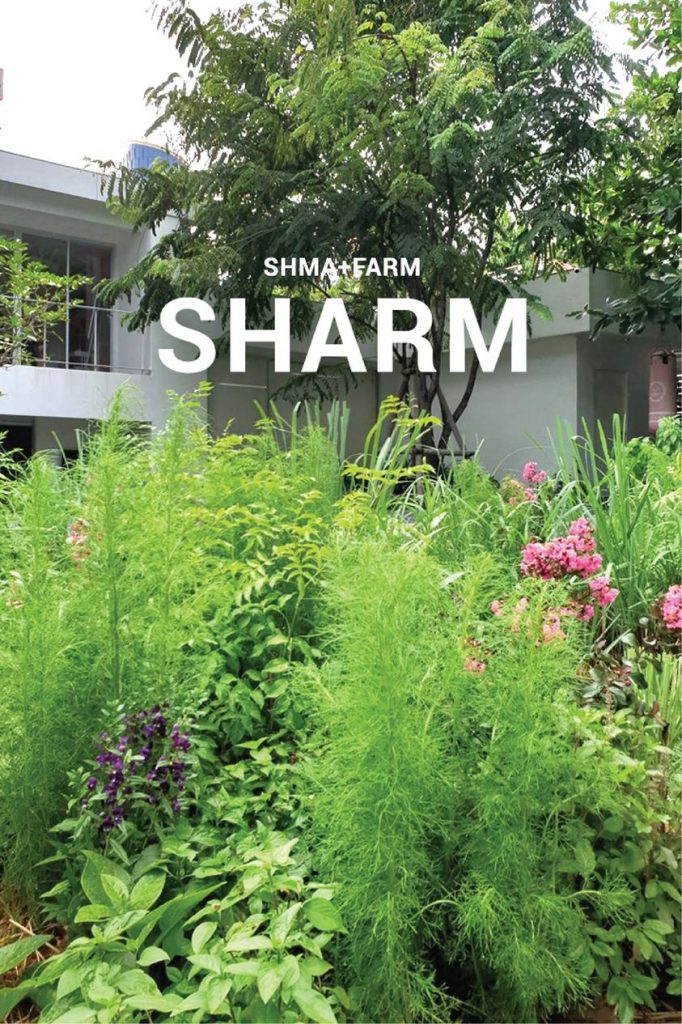
Experimental Conditions
.
[Please scroll down for English Translation]
.
สมมติฐาน
พืชที่เหมาะต่อการปลูกใต้ร่มเงาเท่านั้นหรือสามารถอาศัยอยู่ภายใต้ร่มเงาได้ จะยังคงมีความอุดมสมบูรณ์สุขภาพดีและไม่เสียรูปทรง เมื่อนำมาปลูกในพื้นที่ร่ม
.
ตัวแปรต้น
1 ชนิดพืชพรรณที่หลากหลาย
ตัวแปรตาม
1 การเปลี่ยนแปลงด้านรูปทรงของพืชพรรณเปรียบเทียบระหว่างพืชที่ปลูกในร่มและพืชที่ปลูกโดนแสง
2 การเปลี่ยนแปลงด้านสุขภาพความสมบูรณ์ของพืชพรรณ เปรียบเทียบระหว่างพืชที่ปลูกโดนแสงและพืชที่ปลูกในร่ม
ตัวแปรควบคุม
1 ปริมาณแสง (พื้นที่ในการปลูกพืชต้องเป็นบริเวณใต้ร่มเงา)
2 ปริมาณน้ำ
3 การดูแลรักษา
4 การกำจัดวัชพืช โรค และศัตรูพืช
.
ผลลัพธ์ที่คาดหวังจากการทดลอง
รู้จักชนิดพืชพรรณที่เหมาะกับการปลูกในพื้นที่ร่ม เพื่อนำมาต่อยอดในงานออกแบบภูมิทัศน์และจัดพืชสวน
—
Hypothesis
Plants that are suitable for planting only in the shade or can live in the shade. Those that will remain fertile, healthy, and undeformed when planted in the shaded area.
.
Early-stage Variable
1 Diverse vegetation species
Variables
1 Changes in the shape of vegetation compared between indoor-grown and light-growing plants.
2 Changes in vegetation health, comparing light-based and indoor-grown plants.
Controlled Variables
1 Light amount (Planting area must be shaded area)
2 Water amount
3 Maintenance
4 Weeding, disease, and pest control
.
Expected Results from the Experiment
Learn the types of plants that are suitable for growing in shaded areas to be implemented in landscape design and horticulture.
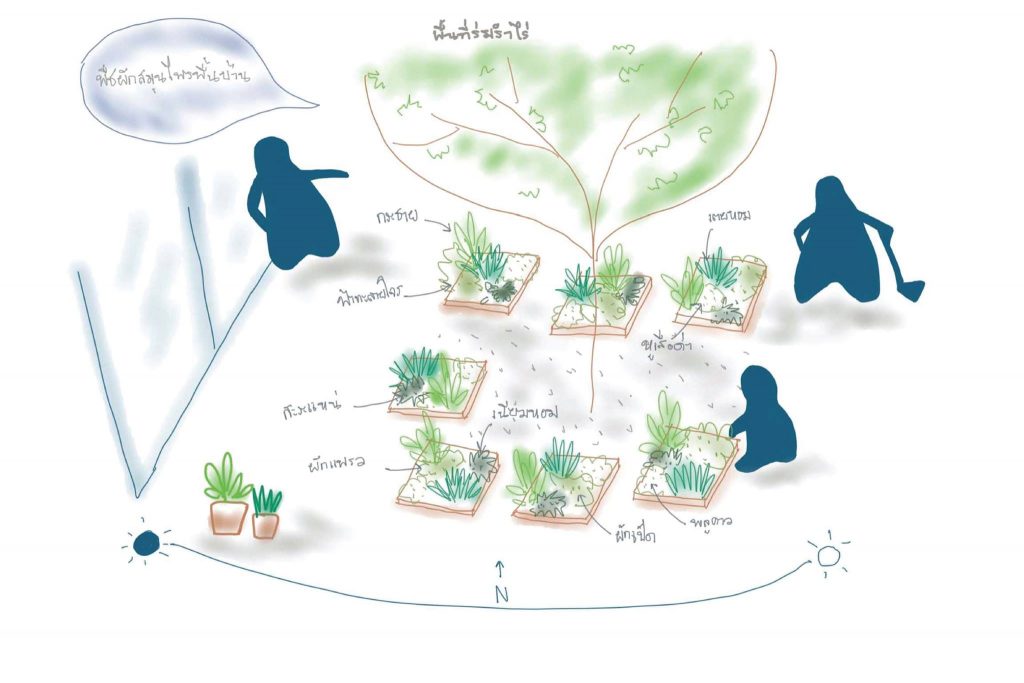
Plot No. 1: Edible Garding
.
[Please scroll down for English Translation]
.
จากความสนใจในสวนผักกินได้ (Edible Garden) และเกษตรในเมือง (Urban Farming) เราใช้โอกาสนี้ออกแบบทดลองเลือกพืชพรรณอย่าง สมุนไพรที่ยังไม่ถูกใช้งานในเชิงออกแบบมากนักมาทดลองปลูกใต้ร่มไม้ต้นกัลปพฤกษ์ นอกจากจะให้ความสวยงามแล้ว ยังสามารถนำมาใช้บริโภคได้ด้วย
.
วัตถุประสงค์
1 เพื่อศึกษาว่าพืชพรรณที่สนใจมีการเปลี่ยนแปลงอย่างไรหากปลูกบริเวณที่ร่ม (ภายใต้ต้นไม้ใหญ่ที่มีพุ่มทึบ)
2 เพื่อศึกษาว่าพืชพรรณชนิดใดสามารถอาศัยในที่ร่มได้
—
Based on our interest in the Edible Garden and Urban Farming, we took this opportunity to design an experimental selection of plants. Herbs that have previously not been used much in designing landscapes are tested out and plotted under the shades of Kalapapruek trees because, in addition to it’s beautiful formation, these herbs can also be used for consumption.
.
Objective
1 To study how plants of interest react to being planted in shaded areas (under thickets of large trees).
2 To study which plants can live in the shade.
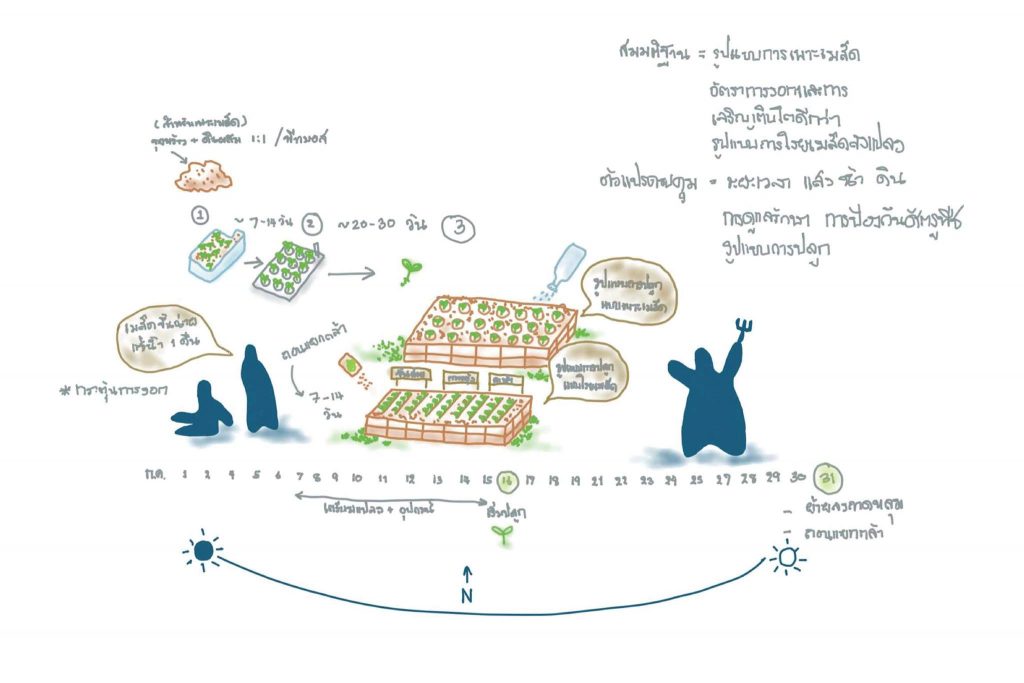
Plot No. 2 and 3: Experimenting Plantation Method
.
[Please scroll down for English Translation]
.
เราทดลองเปรียบเทียบการปลูกสองวิธีคือ การหว่านเมล็ดลงในแปลงปลูกโดยตรง และการเพาะเมล็ดแยกในกระถางปลูกก่อนย้ายมาปลูกที่แปลงอีกที ดูว่ามีผลผลิตแตกต่างกันอย่างไร ใช้เวลาในการทำเท่าไร เพื่อเก็บข้อมูลดูว่าการปลูกแบบไหนที่เหมาะสมกับวิถีชีวิตคนเมืองที่มีเวลาดูแลน้อย เราพยายามควบคุมวิธีการดูแลให้สอดคล้องกับวิถีชีวิตของเราภายใต้เงื่อนไขการเป็นภูมิสถาปนิกและนักออกแบบ เช่น มีเวลาว่างน้อย ต้องอาศัยคุณแม่บ้านมาช่วยรดในตอนเช้ามาก
.
วัตถุประสงค์
1 เพื่อศึกษาความแตกต่างระหว่างการปลูกพืชผักแบบหว่านเมล็ดลงในแปลงปลูกโดยตรง และแบบเพาะเมล็ดในกระถางปลูก
2 เพื่อศึกษาอัตราการงอกและการเจริญเติบโตของพืชผักที่ปลูกแบบหว่านเมล็ดลงในแปลงปลูกโดยตรง และแบบเพาะเมล็ดในกระถางปลูก
3 เพื่อประเมินความคุ้มค่าในการปลูกโดยมีปริมาณและคุณภาพของผลผลิตเป็นตัวชี้วัด
4 เพื่อศึกษาแนวทางกาปลูกพืชผักที่เหมาะสมกับผู้ที่ไม่มีเวลาในการดูแลมากนัก
—
A comparison of two methods of plotting; sowing seeds directly into the field and sowing seeds separately in pots before transplanting them to the plot again. Viewing the outputs, we were able to see how long it takes to plant versus the difference in the yield. The collected data is compared to conclude the best and suitable method for urban lifestyles with less time. A controlled condition of tending is considered in accordance with landscape architects and designers’ lifestyle, having little free time, we require the maid’s help with watering them in the morning.
.
Objective
1 To study the difference between direct sowing of seeds in the field and seeding in the pot.
2 To study the germination and growth rate of vegetables planted by direct sowing in the field and seeding in a pot.
3 To assess the cost-effectiveness of planting with the quantity and quality of the plant products as indicators.
4 To study the approach suitable for those who do not have much time.
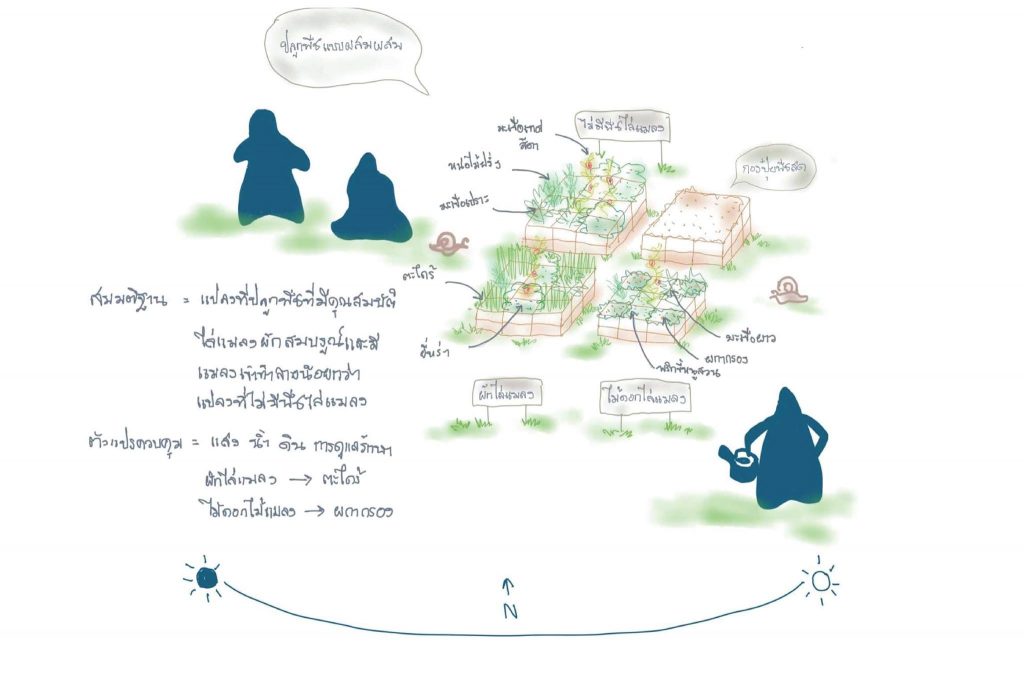
Plot No. 4: Companion Planting
.
[Please scroll down for English Translation]
.
เราทดลองนำทฤษฎีการปลูกพืชแบบผสมผสาน (Companion Planting) มาปรับใช้ในพื้นที่จริงเพื่อสังเกตติดตามผลการเปลี่ยนแปลงต่างๆที่เกิดขึ้นกับพืช เช่น การเจริญเติบโตของผลและใบ ผลกระทบจากโรค แมลงและศัตรูพืช ในฐานนี้เราใช้ มะเขือเทศสีดา เป็นตัวแปรต้นหรือผลผลิตสำหรับการสังเกตการณ์ แบ่งเป็น 4 แปลงคือ หนึ่ง ปลูกมะเขือเทศสีดากับตะไคร้ สอง ปลูกมะเขือเทศสีดากับผกากรอง สาม ปลูกมะเขือเทศสีดากับผักประเภทอื่นๆ และสี่ แปลงสำหรับปุ๋ยพืชสด
.
ทฤษฎีที่นำมาประกอบการทดลอง
1 เกษตรในเมือง (Urban Farming)
เกษตรในเมือง เป็นการปลูกพืชและเลี้ยงสัตว์ภายในหรือรอบพื้นที่เมือง โดยบูรณาการ ความรู้ทางนิเวศวิทยาและเศรษฐศาสตร์ตามสภาพพื้นที่เมือง โดยอาศัยแรงงานและทรัพยากรทั่วไปในพื้นที่เมืองเช่น ปุ๋ยหมักจากขยะอินทรีย์ น้ำสำหรับชลประทานจากน้ำเสียชุมชน
2 การปลูกพืชแบบผสมผสาน (Companion Planting)
การปลูกพืชแบบผสมผสาน คือการนำพืชต่างชนิดกันมาปลูกร่วมกันเพื่อส่งเสริมประสิทธิภาพการเติบโตของกันและกัน เช่น การเพิ่มสารอาหารในดิน หรือการไล่ศัตรูพืช ทั้งนี้ขึ้นอยู่กับการเลือกสรรชนิดที่เหมาะสมต่อกัน
3 การจัดการของเสียในพื้นที่
การจัดการของเสียในพื้นที่ หมายถึงการจัดการทรัพยากรในระบบให้เกิดการหมุนเวียน เช่น การนำซากพืช เศษใบไม้ที่ร่วง มาหมักทำเป็นปุ๋ยพืชสดใช้ประกอบการปลูกพืชต่อไป
.
4 ทฤษฎี Square Foot
การปลูกพืชผักแบบ square foot คือการปลูกผักผลไม้สวนครัวในพื้นที่เล็ก อย่างเป็นระเบียบและให้ผลผลิตมากกว่าการปลูกแบบแถว ถูกคิดค้นขึ้นโดยวิศวกร นักจัดสวนชาวอเมริกัน Mel Bartholomew และเผยแพร่ครั้งแรกในหนังสือ Square Foot Gardening โดยมีวิธีการปลูกคือแบ่งแปลงปลูกขนาด 4×4 ฟุตเป็นกริดขนาด 1×1 ฟุตเท่าๆกัน มีความลึกกระบะประมาณ 150 มม. จากนั้นจึงค่อยปลูกเมล็ดพืขพรรณแต่ละชนิดในช่องนั้นๆ ตามขนาด ความหนาแน่นที่เหมาะสม นอกจากวิธีการนี้จะทำให้พืชผักเติบโตอย่างมีประสิทธิภาพแล้ว ยังไม่ต้องเหยียบย่ำดินเพื่อจัดการ ง่ายต่อการเคลื่อนย้ายและเก็บเกี่ยวอีกด้วย ทั้งนี้ควรเว้นระยะห่างระหว่างต้นแต่ละชนิดไม่ให้กว้างมากเพื่อป้องกันวัชพืชเติบโต และควรปลูกพืชผสมหลากหลายชนิดเพื่อป้องกันโรค แมลงและศัตรูพืช
.
สมมติฐาน
1 การปลูกพืชมีกลิ่นอย่าง ตะไคร้ จะช่วยไล่แมลงหรือช่วยลดความเสียหายที่เกิดจากศัตรูพืช ทำให้พืชผลที่ปลูกอยู่ด้านในมีความสมบูรณ์มากขึ้น
2 การปลูกพืชสีสันอย่าง ผกากรองจะช่วยดึงดูดแมลงและศัตรูพืชจึงช่วยลดความเสียหายที่เกิดกับพืชผล ที่ปลูกอยู่ด้านใน
3 การปลูกต้นพืชผสมผสานจะทำให้เกิดศัตรูพืช ที่เข้าทำลายพืชผลที่ปลูกอยู่ด้านในมากกว่าอีกสองแปลง
—
We applied the theory of Companion Planting to real-life situations in order to observe and monitor changes that occur in plants such as fruit and leaf growth rate and the effects of diseases, insects, and pests. In this plot, we use Sita Tomato as our primary subject for yield variable for the observation. The plot is divided into four: firstly, Sita Tomatoes and Lemongrass, secondly, Sita Tomatoes and Indian Lantana, thirdly, Sita Tomatoes and other vegetables, and lastly, green manure.
.
Theories Applied to the Experiment
1 Urban Farming
Urban Farming is growing crops and farming animals within or around urban areas by integrating the knowledge of ecology and economics according to urban conditions. Relying on labor and general resources in urban areas such as compost from organic waste from local wastewater.
2 Companion Planting
This is the planting of different plant species with different quality together to naturally promote the efficiency of each other’s growth, such as species that increases nutrients in the soil or pest repelling. The combination depends on the selection of suitable species.
3 Waste Management
Local Waste Management refers to the management of resources in the surrounding ecosystem to achieve sustainability, such as plant remains or fallen leaves removed to be composted into green manure for further fertilization.
.
4 Square Foot Theory
Square Foot vegetation is the theory that implies that growing edible vegetables and fruits in an orderly manner will generate a higher yield than row planting. This theory was invented by an engineer American gardener Mel Bartholomew, who first introduced it in his published book Square Foot Gardening. This method advises dividing a 4×4-foot plot into an equal 1×1-foot grid, with a pickup depth of approximately 150 mm, then plant the seeds in that channel according to size and density appropriate. In addition, this method will allow vegetations to grow more efficiently and gives more space for gardeners to walk around the soil when managing making plants easier to transport and harvest. However, the distance between each plant should not be too far apart to prevent weeds from growing a variety of different plant selection should be grown to prevent diseases, insects, and pests.
.
Hypothesis
1 Growing aromatic plants like lemongrass will either repel insects or reduce the damage caused by pests granting plants a safe environment to grow in.
2 Colourful crops will attract insects and pests, thereby reducing damage to crops planted inside the plot.
3 Intercropping plants will attract pests to enter destroying them more than the other two plots.
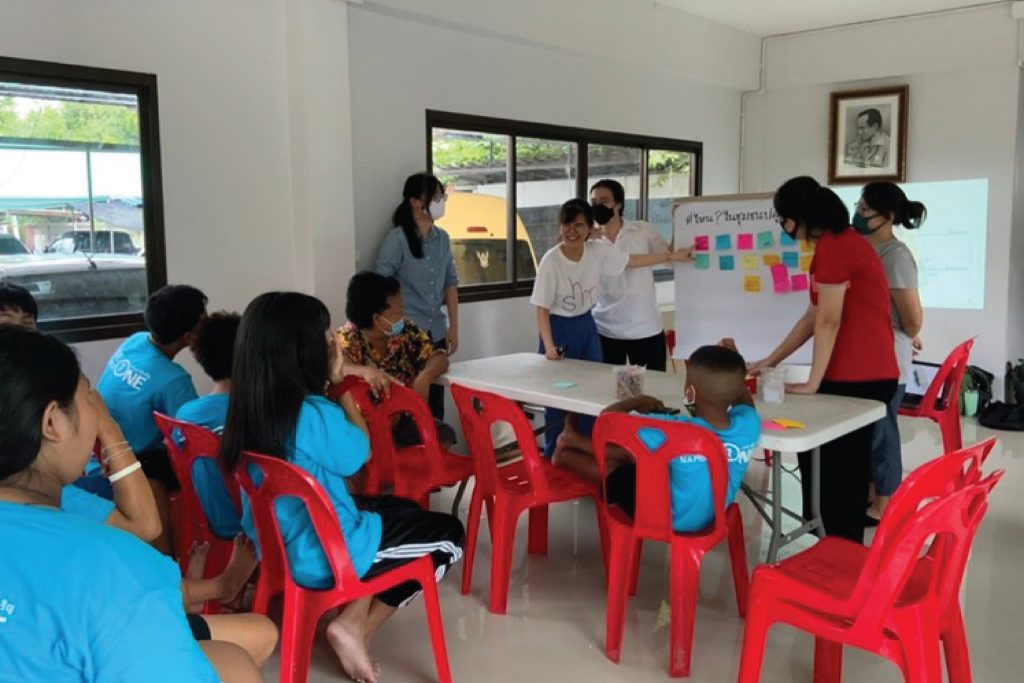
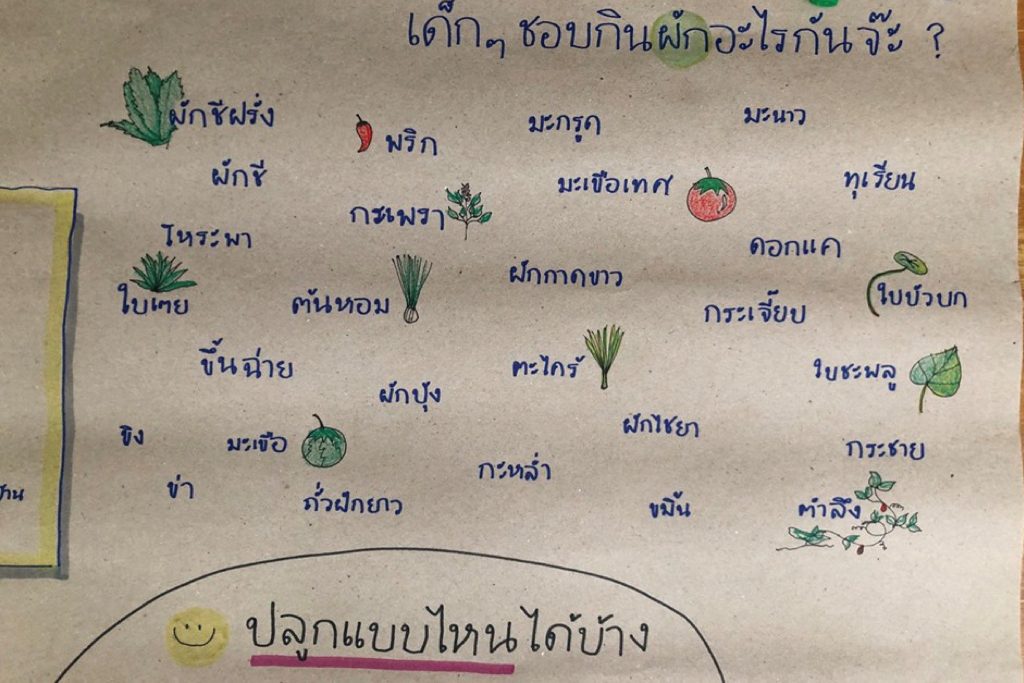
Social Impact
.
[Please scroll down for English Translation]
.
ผลงานของ Social Team ไม่ได้เพียงเท่านี้ นอกจากเป้าหมายการส่งเสริมความกินดีอยู่ดีของคนในออฟฟิศแล้ว เราอยากแบ่งปันองค์ความรู้เรื่องการทำสวนผักกินได้ และการออกแบบภูมิทัศน์แก่สังคมด้วย โดยต่อยอดเป็นโครงการ สวนผักชุมชนคลองลัดภาชีที่เราได้ร่วมพัฒนากับ พอช. หรือ สถาบันพัฒนาองค์กรชุมชน (องค์การมหาชน) มีเป้าหมายเพื่อวางผังปลูกผลผลิตกินได้และพื้นที่ส่วนกลางต่างๆ พร้อมพัฒนาวิธีการจัดการที่มีประสิทธิภาพ
.
เรามองว่า อาหาร ที่เก็บเกี่ยวเองกับมือในแปลงปลูกและนำมาปรุงเป็นมื้ออาหารในครัวกลาง เปรียบเสมือนตัวกลางสำคัญที่เชื่อมความสัมพันธ์ของคนในชุมชนได้ เราเลยเริ่มต้นจากการลงพื้นที่ชุมชนคลองลัดภาชี จัดทำกระบวนการมีส่วนร่วมระดมไอเดียจากทั้งเด็กและผู้ใหญ่ เก็บข้อมูลชนิดพืชผักสวนครัวที่ปลูกอยู่แล้วในชุมชน เพื่อทำความเข้าใจต้นทุนเดิมและความต้องการของพวกเขาให้ได้มากที่สุด ปัจจุบันโครงการนี้ยังคงอยู่ระหว่างการดำเนินการ มีการลงชุมชน จัดกิจกรรม ออกแบบพื้นที่และการจัดการใหม่อย่างค่อยเป็นค่อยไป
—
The work of the Social Team continues as the goal is to share our knowledge of edible plant gardening and landscape design for society with the local community. Hence, this project is extended to a project in Khlong Lat Phachi, that we have developed with the National Council for Peace and Order or the Community Organization Development Institute (Public Organization), which aims to spread edible vegetation in public common areas and develop effective management methods.
.
From our point of view food that is hand-harvested in the field and cooked as a meal in the central kitchen represents an important intermediary that connects people in the community together. Starting with visiting the Khlong Lat Phachi community, creating an engaging process of brainstorming ideas from both children and adults, collecting data on types of vegetables that already have in the community, to understanding the acceptable cost and their other needs as much as possible. Currently, this project is still in the process of gradual entry into other communities through organization of activities, redesigning the area, and managing it.


